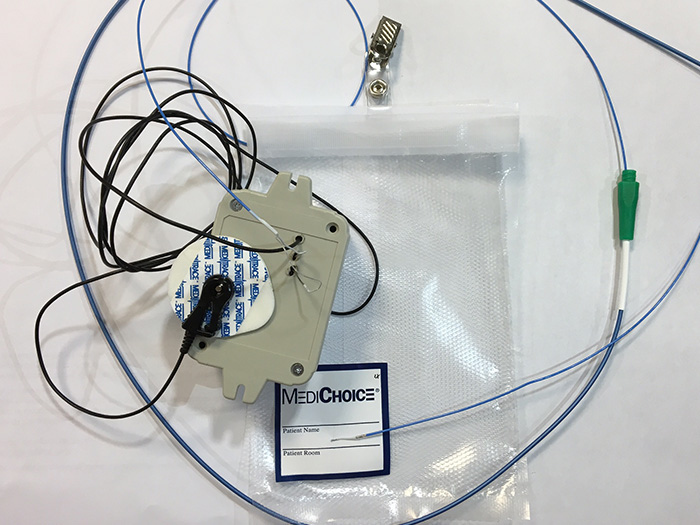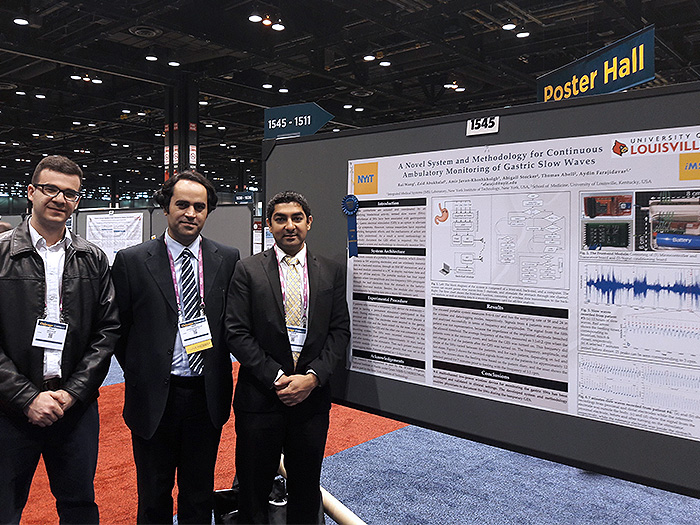News
Tummy Tech: New Device Diagnoses Your Gut
May 8, 2017
Digest this: As many as five million Americans suffer from gastroparesis—a condition which results when the stomach muscles do not function normally and cause the stomach’s contents to empty too slowly. This can bring on heartburn, nausea, vomiting, abdominal bloating, poor appetite, and weight loss.
The cause of the disease is unknown and the underlying bioelectric activity that initiates gastric contractions, known as slow waves, is not fully understood. But a new device developed by Aydin Farajidavar, Ph.D., assistant professor at NYIT School of Engineering and Computing Sciences, could shed light on why this condition occurs.
Farajidavar worked with four electrical and computer engineering master’s candidates (Rui Wang, Zaid Abukhalaf, Wahib Alrofati, and Anurag Ravisailekha) and post-doctoral fellow Amir Javan-Khoshkholgh, Ph.D., to develop the portable module that can document gastric contractions in patients suffering from gastroparesis. The project is part of an ongoing effort in the Integrated Medical System (IMS) Laboratory, housed in the School of Engineering and Computing Sciences, to create devices to better diagnose gastrointestinal disorders and diseases.

Photo: This revolutionary device could better diagnose gastrointestinal disorders and diseases.
“Now that activity in the stomach can be measured, this project could ultimately revolutionize how some digestive diseases can be diagnosed and treated,” Farajidavar said. “In the IMS Lab, we are developing the next generation of such devices to not only record gastric activity, but also to provide electrical stimulation that has therapeutic effect.”
Farajidavar also noted that this is the first Holter monitor—a battery-operated portable device that measures and records heart activity, like an electrocardiogram—to be developed for the stomach. The device consists of a portable module that connects to electrodes that acquire gastric signals. These signals are then sent wirelessly to a receiver connected to a PC and stored for analysis offline. “This module also operates independently by logging data on a micro SD memory card. This is an important feature because it allows us to log data for long-term studies,” explained Farajidavar.

Photo: Zaid Abukhalaf, Amir Jarvan-Khoshkhlogh, Ph.D., and Aydin Farajidavar, Ph.D., at Digestive Disease Week 2017.
To test the device’s functionality, the team enlisted nine patients registered at University of Louisville Medical Center for their research studies. In most cases, signals were recorded and analyzed successfully in terms of frequency and amplitudes. The frequency, amplitude, and shape of the short waves varied between patients, and for each patient, varied between fed- and fast-states. “We are hoping to continue our path and involve more patients and care takers,” said Farajidavar.
In addition, Farajidavar’s groundbreaking work, “A Novel System and Methodology for Continuous Ambulatory Monitoring of Gastric Slow Waves,” was selected as a Poster of Distinction at Digestive Disease Week 2017—the world’s largest gathering of physicians, researchers, and industry leaders in the fields of gastroenterology, hepatology, endoscopy, and gastrointestinal surgery.
Read more about the study.



_Thumb.jpg)

